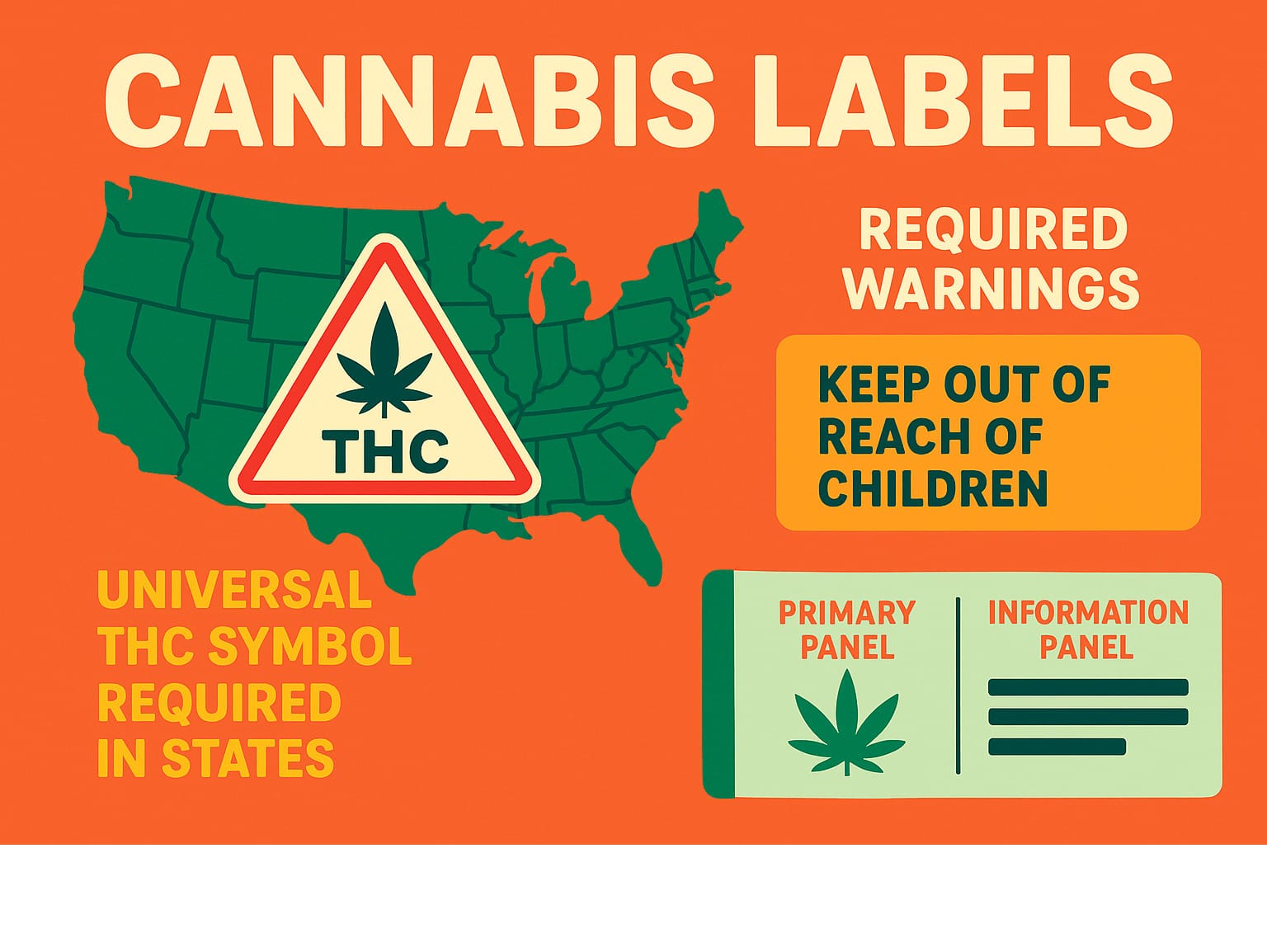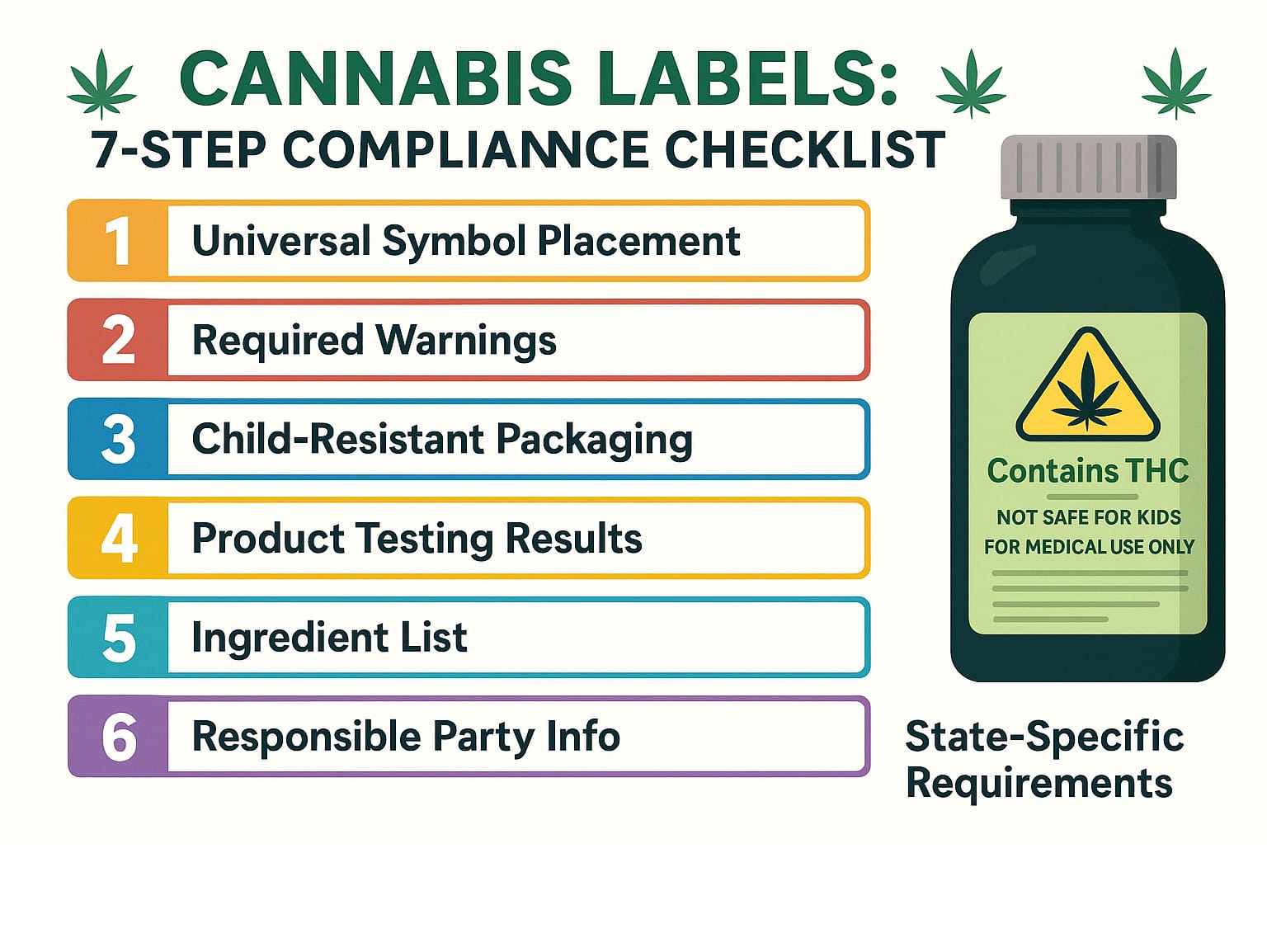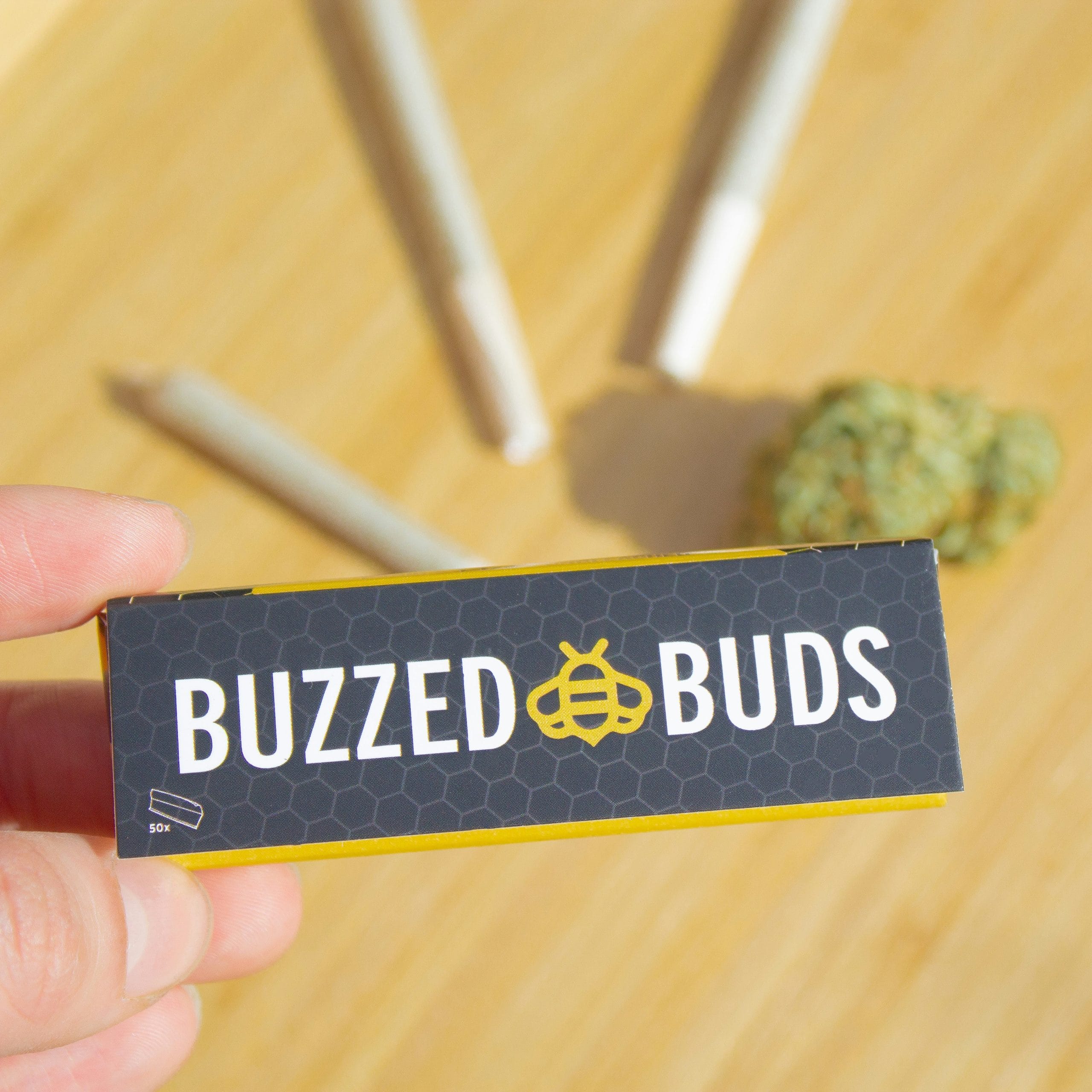Navigating the Complex World of Cannabis Labels
Cannabis labels are the essential identification cards for every legal marijuana product on the market today. They provide crucial information about content, potency, safety, and legal compliance that both consumers and regulators rely on.
Quick Guide to Cannabis Label Requirements:
| Required Element | Purpose | Required in States |
|---|---|---|
| Universal THC Symbol | Visual warning of THC content | 80%+ of states |
| THC/CBD Content | Shows potency levels | 100% of states |
| Batch/Lot Number | Enables product tracking | >80% of states |
| Health Warnings | Consumer safety information | >80% of states |
| Manufacturer Contact | Accountability information | 100% of states |
| Child Warning | Prevents accidental consumption | >80% of states |
As the cannabis industry grows rapidly across the United States, understanding label requirements has become essential for producers, retailers, and consumers alike. With legalization expanding state by state, cannabis product labels must balance strict regulatory compliance with consumer education and brand identity.
The challenge? Requirements vary dramatically between states, with an average of 16.7 required label attributes per state, ranging from as few as 4 to as many as 26 different elements. All states require THC content and manufacturer contact information, but fewer than half mandate storage recommendations or usage instructions.

Cannabis Labels 101: Federal Baseline & Universal Elements
While cannabis remains federally illegal in the United States, a patchwork of state regulations has emerged to govern its sale and labeling. Despite this fragmentation, certain universal elements have become standard across nearly all jurisdictions.
This lack of standardization creates challenges for multi-state operators and confusion for consumers crossing state lines. However, several core elements have emerged as nearly universal requirements:
- THC content: Required in 100% of states with legal cannabis programs
- Manufacturer contact information: Required in 100% of states
- Batch number: Required in over 80% of states
- Health risks: Required in over 80% of states
- Production tracking: Required in over 80% of states
- Cannabis symbol: Required in over 80% of states
- CBD content: Required in over 80% of states
- Children disclaimer: Required in over 80% of states
- Impairment disclaimer: Required in over 80% of states
While the FDA has yet to establish comprehensive cannabis labeling guidelines (as it does for food and pharmaceuticals), state regulations have largely filled this gap. Most have modeled their requirements after established systems for alcohol, tobacco, and pharmaceutical products.
Anatomy of Cannabis Labels: Primary vs Information Panel
Most states divide cannabis labels into two main sections: the primary panel and the information panel.
The primary panel typically appears on the front or top of the package and must include:
- Product identity: What the product is (e.g., “Pre-Roll,” “Gummy Edibles”)
- Net weight: Total amount in both metric and U.S. customary units (e.g., “3.5 g / 0.125 oz”)
- Universal symbol: The state-mandated cannabis warning symbol
The information panel, usually on the back or side of the package, contains:
- UID number: Unique identifier for tracking
- Licensee information: Manufacturer name and contact details
- Packaging date: When the product was packaged
- Government warning: State-mandated warning statements
- Cannabinoid content: THC and CBD percentages or milligrams
In California, for example, the Department of Cannabis Control requires that all information be “clearly and legibly displayed on the outside of packaging” and be “in English with a minimum 6-point font.”
Canada offers an interesting comparison, with its national Cannabis Act establishing consistent labeling requirements across all provinces. Canadian labels must be bilingual (English and French) and display a standardized cannabis symbol, health warning messages, and THC/CBD content.
| Requirement | United States | Canada |
|---|---|---|
| Standardized Symbol | Varies by state | Universal leaf symbol |
| Language | English | Bilingual (EN/FR) |
| Warnings | Varies by state | Standardized health warnings |
| Cannabinoid Display | Either % or mg/g | Both THC/CBD “as purchased” and “total” |
| Minimum Font | 6pt in most states | 6pt for most text, 7pt for warnings |
Required Information on Every Package
Every cannabis label must include critical information to be compliant in virtually all jurisdictions. Michigan cannabis labeling is no different:
THC and CBD Content: This can be displayed as a percentage (for flower), milligrams per gram (for concentrates), or total milligrams (for edibles). For edibles, most states require both the total THC per package and the amount per serving.
As one label from Washington State explains: “Most cannabis flower products have between 12% and 25% THC. Concentrates generally range from 60–90% THC.”
Health and Impairment Warnings: These typically include statements about:
- Not operating vehicles or machinery while under the influence
- Keeping away from children
- Potential health risks
- Age restrictions
Production Tracking Information: This includes batch or lot numbers and packaging dates, which are essential for recalls and quality control.
In Michigan and California, labels must include a UID (Unique Identifier) number that allows regulators to track the product through the state’s track-and-trace system.
Manufacturer Information: The name and contact information of the licensed producer must be clearly displayed, providing accountability and a point of contact for consumers.
Universal Symbols & Warning Statements
Most states require a universal symbol that instantly identifies a product as containing cannabis. These symbols serve as a quick visual warning, especially important for preventing accidental consumption.
California’s universal cannabis symbol must appear on the primary panel of all cannabis goods and measure at least 0.5 inch by 0.5 inch. It consists of a triangle with an exclamation point and a cannabis leaf, accompanied by the letters “CA.”
Michigan also uses a “Not for Kids” symbol alongside their universal cannabis symbol, emphasizing the importance of keeping products away from children.
California also requires Proposition 65 warnings on cannabis products, which inform consumers about exposure to chemicals known to cause cancer or reproductive harm. Since 2009, cannabis has been classified as a carcinogen in California, and as of January 3, 2020, both marijuana smoke and THC are listed as reproductive toxins.
Canada’s standardized cannabis symbol features a red stop sign with a cannabis leaf and “THC” text. This symbol must appear on any product containing more than 10 μg/g (micrograms per gram) of THC.
Warning statements must typically be displayed in bold, capital letters, and often in a specific font size. For example, California requires the government warning to be in “bold capital letters.”
How Consumers Decode Cannabis Labels
For consumers, understanding how to read cannabis labels is essential for safe and informed use.
Understanding Potency: THC content is typically displayed in one of three ways:
- Percentage (%) for flower (e.g., 18% THC)
- Milligrams per gram (mg/g) for concentrates
- Total milligrams (mg) for edibles, with per-serving amounts
For edibles, it’s crucial to note both the per-serving and total package THC content. In most states, edibles are limited to 10mg THC per serving and 100mg per package. A package of four gummies labeled “2.5mg THC per unit” contains 10mg total THC.
- Activation Time: Some products, particularly edibles, may include information about onset time. This helps consumers understand when effects might begin and how long they might last.
- Storage Guidance: Proper storage recommendations help maintain product quality and safety. For example, some concentrates require refrigeration, while flower should be kept in a cool, dark place.
- Allergen Information: For edibles, allergen lists are critical for consumer safety. Common allergens like nuts, dairy, or gluten must be clearly identified.
- Certificate of Analysis Access: Many products now include QR codes that link to laboratory test results, allowing consumers to verify cannabinoid content and confirm that the product has passed safety testing for contaminants.
Packaging Must-Haves: Child-Resistant & Tamper-Evident
The packaging itself must meet specific safety standards beyond just what’s printed on the label. Child-resistant packaging is non-negotiable in most states, requiring containers that meet the Poison Prevention Packaging Act standards—meaning they must be significantly difficult for children under five to open.
This requirement becomes even more critical for edible products that could easily be mistaken for regular candies or baked goods. The industry has responded with innovative packaging solutions, including special caps, push-and-turn mechanisms, and childproof pouches.
Tamper-evident features are equally important, giving consumers visible indicators if a product has been opened or compromised. These include shrink bands, perforated seals, safety buttons on lids, and breakable caps—similar to what you see on over-the-counter medications.
For multi-serving products, resealable packaging maintains child-resistance throughout the product’s life. Many states also require opaque packaging for edibles so the contents aren’t visible, reducing their appeal to children.
As the industry matures, we’re seeing increasing focus on sustainability alongside safety. Innovative packaging solutions now balance child-resistance with environmental responsibility through recyclable materials and designs that use less plastic.
Spotting & Avoiding Common Cannabis Label Mistakes
Even experienced producers make cannabis label mistakes that can lead to serious consequences. Here are the pitfalls to avoid:
Font size issues trip up many companies—most states require a minimum 6-point font for all required information. Text that’s too small might save space but risks non-compliance.
Missing tracking information like batch numbers, UID numbers, or packaging dates prevents proper product tracing and can trigger automatic regulatory flags.
Unproven health claims remain strictly prohibited. Statements like “cures insomnia” or “treats anxiety” can’t appear on labels unless backed by FDA-approved research.
Weight display errors are surprisingly common—most jurisdictions require both metric and U.S. customary units (e.g., “3.5g / 0.125oz”).
Absent warnings or universal symbols are immediately noticeable to inspectors and often result in immediate compliance action.
THC calculation errors, particularly for edibles, can lead to serious consequences beyond regulatory issues—consumers may have unexpected experiences if dosing information is incorrect.
The penalties for these mistakes can be severe: product recalls, substantial fines, license suspension, brand reputation damage, and potential legal liability. California’s Department of Cannabis Control actively investigates non-compliant products and provides an online complaint form for reporting violations.
Reading Cannabis Labels for Safety & Dosing
For consumers, understanding how to read cannabis labels is essential for safe and effective use. The cannabinoid ratio (THC to CBD) significantly impacts effects—higher CBD relative to THC typically results in less intoxication and more therapeutic benefits.
Some premium products list terpene profiles, offering insight into potential effects and aromas. The industry is increasingly educating consumers about how these compounds contribute to the overall experience.
Many forward-thinking brands now include QR codes linking to Certificates of Analysis, allowing consumers to verify exact cannabinoid content and confirm safety testing results with a simple smartphone scan.
Safety warnings like impaired driving disclaimers and poison control information provide crucial guidance. For edibles, delayed effect notices remind consumers that effects may take 30 minutes to 2 hours to appear—helping prevent the common mistake of taking more before the first dose takes effect.
Dosing information is particularly crucial for edibles. While a standard serving is typically 5-10mg of THC, new or occasional users should start with much lower doses (1-2.5mg). Clear serving size information helps consumers make informed decisions and have positive experiences.
Importance of Cannabis Label Compliance
Producing compliant cannabis labels can feel like a maze of regulations, symbols, and tiny print. But understanding these crucial product “ID cards” is essential for everyone involved in the cannabis journey.
At Whitlam Group, we’ve spent over 60 years perfecting the art and science of label engineering. Our deep experience with complex regulatory environments makes us uniquely qualified to help cannabis businesses steer the labeling landscape – especially those operating across multiple states with different rules.
The consequences of getting cannabis labels wrong aren’t minor. For businesses, non-compliance can trigger expensive recalls, hefty fines, and reputation damage that’s hard to repair. For consumers, clear and accurate labels are literally the difference between a positive experience and potentially serious adverse effects.
Think about what these labels actually accomplish:
- Regulatory compliance – keeping businesses operational and legal
- Consumer education and safety – providing crucial dosing and warning information
- Brand identity – helping products stand out in an increasingly crowded market
- Product tracking – ensuring quality control and enabling recalls when necessary
As this young industry matures, we’ll likely see more standardization in labeling requirements across states, following Canada’s national model. Until then, partnering with experienced labeling experts who understand each market’s unique requirements remains the smartest approach.

